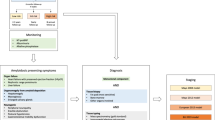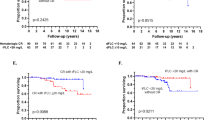Summary:
Stem cell transplantation was introduced as a new therapeutic modality for amyloidosis. The purpose of the current study was to determine the feasibility and toxicity of stem cell transplantation for amyloidosis in a cooperative group setting in which most participating institutions would have limited experience in managing the disorder. A total of 30 patients with biopsy-proven amyloidosis shown to be immunoglobulin light-chain type were enrolled on this trial. The protocol required mobilization of a minimum of 6 × 108 mononuclear cells/kg or 5 × 106 CD34+ cells/kg ideal body weight. These targets had to be achieved within seven collections. Patients with advanced hepatic, renal, or cardiac failure were excluded. End points included objective response rate and overall survival. The secondary end point of the protocol was nonhematologic toxicity. Accrual to the study was faster than expected. The overall response rate (hematologic and organ) was 64%, with three treatment-related deaths. Another patient died before day 30 of sudden cardiac death not treatment related. The median follow-up of surviving patients is 30.3 months. Median survival has not been reached. Stem cell transplantation for selected patients with amyloidosis is feasible in a cooperative group setting. A multicenter phase 3 trial of high-dose therapy is indicated.
This is a preview of subscription content, access via your institution
Access options
Subscribe to this journal
Receive 12 print issues and online access
$259.00 per year
only $21.58 per issue
Buy this article
- Purchase on Springer Link
- Instant access to full article PDF
Prices may be subject to local taxes which are calculated during checkout
Similar content being viewed by others
References
Comenzo RL, Vosburgh E, Simms RW et al. Dose-intensive melphalan with blood stem cell support for the treatment of AL amyloidosis: one-year follow-up in five patients. Blood 1996; 88: 2801–2806.
Gertz MA, Lacy MQ, Dispenzieri A et al. Stem cell transplantation for the management of primary systemic amyloidosis. Am J Med 2002; 113: 549–555.
Reich G, Held T, Siegert W et al. Four patients with AL amyloidosis treated with high-dose chemotherapy and autologous stem cell transplantation. Bone Marrow Transplant 2001; 27: 341–343.
Choufani EB, Sanchorawala V, Ernst T et al. Acquired factor X deficiency in patients with amyloid light-chain amyloidosis: incidence, bleeding manifestations, and response to high-dose chemotherapy. Blood 2001; 97: 1885–1887.
Gertz MA, Lacy MQ, Gastineau DA et al. Blood stem cell transplantation as therapy for primary systemic amyloidosis (AL). Bone Marrow Transplant 2000; 26: 963–969.
Sezer O, Niemoller K, Jakob C et al. Novel approaches to the treatment of primary amyloidosis. Expert Opin Investig Drugs 2000; 9: 2343–2350.
Gertz MA, Lacy MQ, Dispenzieri A . Myeloablative chemotherapy with stem cell rescue for the treatment of primary systemic amyloidosis: a status report. Bone Marrow Transplant 2000; 25: 465–470.
Saba N, Sutton D, Ross H et al. High treatment-related mortality in cardiac amyloid patients undergoing autologous stem cell transplant. Bone Marrow Transplant 1999; 24: 853–855.
Patriarca F, Geromin A, Fanin R et al. Improvement of amyloid-related symptoms after autologous stem cell transplantation in a patient with hepatomegaly, macroglossia and purpura. Bone Marrow Transplant 1999; 24: 433–435.
Sezer O, Schmid P, Shweigert M et al. Rapid reversal of nephrotic syndrome due to primary systemic AL amyloidosis after VAD and subsequent high-dose chemotherapy with autologous stem cell support. Bone Marrow Transplant 1999; 23: 967–969.
Comenzo RL, Sanchorawala V, Fisher C et al. Intermediate-dose intravenous melphalan and blood stem cells mobilized with sequential GM+G-CSF or G-CSF alone to treat AL (amyloid light chain) amyloidosis. Br J Haematol 1999; 104: 553–559.
Schulenburg A, Kalhs P, Oberhuber G et al. Gastrointestinal perforation early after peripheral blood stem cell transplantation for AL amyloidosis. Bone Marrow Transplant 1998; 22: 293–295.
Majolino I, Marceno R, Pecoraro G et al. High-dose therapy and autologous transplantation in amyloidosis-AL. Haematologica 1993; 78: 68–71.
Sanchorawala V, Wright DG, Seldin DC et al. An overview of the use of high-dose melphalan with autologous stem cell transplantation for the treatment of AL amyloidosis. Bone Marrow Transplant 2001; 28: 637–642.
Dember LM, Sanchorawala V, Seldin DC et al. Effect of dose-intensive intravenous melphalan and autologous blood stem-cell transplantation on AL amyloidosis-associated renal disease. Ann Intern Med 2001; 134: 746–753.
Skinner M, Anderson J, Simms R et al. Treatment of 100 patients with primary amyloidosis: a randomized trial of melphalan, prednisone, and colchicine versus colchicine only. Am J Med 1996; 100: 290–298.
Kyle RA, Gertz MA, Greipp PR et al. A trial of three regimens for primary amyloidosis: colchicine alone, melphalan and prednisone, and melphalan, prednisone, and colchicine. N Engl J Med 1997; 336: 1202–1207.
Dispenzieri A, Lacy MQ, Kyle RA et al. Eligibility for hematopoietic stem-cell transplantation for primary systemic amyloidosis is a favorable prognostic factor for survival. J Clin Oncol 2001; 19: 3350–3356.
Greipp PR, Trendle MC, Leong T et al. Is flow cytometric DNA content hypodiploidy prognostic in multiple myeloma? Leuk Lymphoma 1999; 35: 83–89.
Oken MM, Leong T, Lenhard RE Jr et al. The addition of interferon or high dose cyclophosphamide to standard chemotherapy in the treatment of patients with multiple myeloma: Phase III Eastern Cooperative Oncology Group Clinical Trial EST 9486. Cancer 1999; 86: 957–968.
Greipp PR, Leong T, Bennett JM et al. Plasmablastic morphology – an independent prognostic factor with clinical and laboratory correlates: Eastern Cooperative Oncology Group (ECOG) myeloma trial E9486 report by the ECOG Myeloma Laboratory Group. Blood 1998; 91: 2501–2507.
Oken MM, Harrington DP, Abramson N et al. Comparison of melphalan and prednisone with vincristine, carmustine, melphalan, cyclophosphamide, and prednisone in the treatment of multiple myeloma: results of the Eastern Cooperative Oncology Group Study E2479. Cancer 1997; 79: 1561–1567.
Kay NE, Leong TL, Bone N et al. Blood levels of immune cells predict survival in myeloma patients: results of an Eastern Cooperative Oncology Group phase 3 trial for newly diagnosed multiple myeloma patients. Blood 2001; 98: 23–28.
Gertz MA, Kyle RA, Greipp PR . Response rates and survival in primary systemic amyloidosis. Blood 1991; 77: 257–262.
Bladé J, Samson D, Reece D et al. Myeloma Subcommittee of the EBMT Chronic Leukaemia Working Party and the Myeloma Working Committee of the IBMTR and ABMTR. Criteria for evaluating disease response and progression in patients with multiple myeloma treated by high-dose therapy and haemopoietic stem cell transplantation. Br J Haematol 1998; 102: 1115–1123.
Kaplan EL, Meier P . Nonparametric estimation from incomplete observations. J Am Stat Assoc 1958; 53: 457–481.
Gertz MA, Rajkumar SV . Primary systemic amyloidosis. Curr Treat Options Oncol 2002; 3: 261–271.
Ichida M, Imagawa S, Ohmine K et al. Successful treatment of multiple myeloma-associated amyloidosis by interferon-alpha, dimethyl sulfoxide, and VAD (vincristine, adriamycin, and dexamethasone). Int J Hematol 2000; 72: 491–493.
Gertz MA, Lacy MQ, Lust JA et al. Phase II trial of high-dose dexamethasone for previously treated immunoglobulin light-chain amyloidosis. Am J Hematol 1999; 61: 115–119.
Wardley AM, Jayson GC, Goldsmith DJ et al. The treatment of nephrotic syndrome caused by primary (light chain) amyloid with vincristine, doxorubicin and dexamethasone. Br J Cancer 1998; 78: 774–776.
Dhodapkar MV, Merlini G, Solomon A . Biology and therapy of immunoglobulin deposition diseases. Hematol Oncol Clin N Am 1997; 11: 89–110.
Gertz MA, Lacy MQ, Lust JA et al. Prospective randomized trial of melphalan and prednisone versus vincristine, carmustine, melphalan, cyclophosphamide, and prednisone in the treatment of primary systemic amyloidosis. J Clin Oncol 1999; 17: 262–267.
Attal M, Harousseau JL . Randomized trial experience of the Intergroupe Francophone du Myelome. Semin Hematol 2001; 38: 226–230.
Hawkins PN, Aprile C, Capri G et al. Scintigraphic imaging and turnover studies with iodine-131 labeled serum amyloid P component in systemic amyloidosis. Eur J Nucl Med 1998; 25: 701–708.
Moreau P, Leblond V, Bourquelot P et al. Prognostic factors for survival and response after high-dose therapy and autologous stem cell transplantation in systemic AL amyloidosis: a report on 21 patients. Br J Haematol 1998; 101: 766–769.
Gertz MA, Lacy MQ, Bjornsson J, Litzow MR . Fatal pulmonary toxicity related to the administration of granulocyte colony-stimulating factor in amyloidosis: a report and review of growth factor-induced pulmonary toxicity. J Hematother Stem Cell Res 2000; 9: 635–643.
Kumar S, Dispenzieri A, Lacy MQ et al. High incidence of gastrointestinal tract bleeding after autologous stem cell transplant for primary systemic amyloidosis. Bone Marrow Transplant 2001; 28: 381–385.
Kyle RA, Linos A, Beard CM et al. Incidence and natural history of primary systemic amyloidosis in Olmsted County, Minnesota, 1950 through 1989. Blood 1992; 79: 1817–1822.
Acknowledgements
This study was conducted by the Eastern Cooperative Oncology Group (Robert L Comis, MD) and supported in part by Public Health Service Grants CA23318, CA6636, CA21115, CA13650, and CA49883, the National Cancer Institute, National Institutes of Health, and the Department of Health and Human Services. Its contents are solely the responsibility of the authors and do not necessarily represent the official views of the National Cancer Institute.
Author information
Authors and Affiliations
Corresponding author
Rights and permissions
About this article
Cite this article
Gertz, M., Blood, E., Vesole, D. et al. A multicenter phase 2 trial of stem cell transplantation for immunoglobulin light-chain amyloidosis (E4A97): an Eastern Cooperative Oncology Group Study. Bone Marrow Transplant 34, 149–154 (2004). https://doi.org/10.1038/sj.bmt.1704539
Received:
Accepted:
Published:
Issue Date:
DOI: https://doi.org/10.1038/sj.bmt.1704539
Keywords
This article is cited by
-
Current status of hematopoietic cell transplantation in the treatment of systemic amyloid light-chain amyloidosis
Bone Marrow Transplantation (2012)
-
Multiple myeloma-associated AL amyloidosis: is a distinctive therapeutic approach warranted?
Bone Marrow Transplantation (2006)
-
Amyloidosis
Current Treatment Options in Oncology (2006)
-
Autologous transplantation for primary systemic AL amyloidosis is feasible outside a major amyloidosis referral centre: the Calgary BMT Program experience
Bone Marrow Transplantation (2005)



